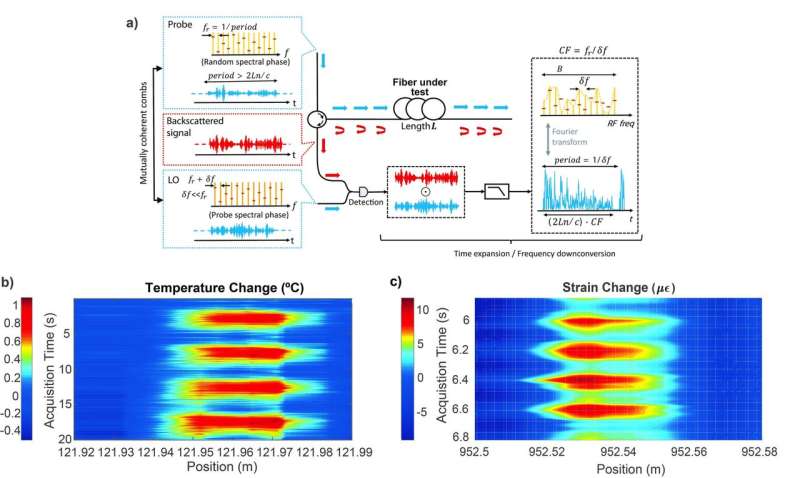Time-expanded phase-sensitive optical time-domain reflectometry

Distributed optical fiber sensing (DOFS) is currently a mature technology that allows 'transforming' a conventional fiber optic into a continuous array of individual sensors, which are distributed along its length. Between the panoply of techniques developed in the field of DOFS, those based on phase-sensitive optical time-domain reflectometry (ΦOTDR) have gained a great deal of attention, mainly due to their ability to measure strain and temperature perturbations in real time. These unique features, along with other advantages of distributed sensors (reduced weight, electromagnetic immunity and small size) make ΦOTDR sensors an excellent solution for monitoring large infrastructures (like bridges and pipelines), especially when considering that their cost scales inversely to the number of sensing points, and its resolution can achieve a few meters.
In a new paper published in Light Science & Applications, a team of scientists from the University of Alcalá, University Jaume I and the Spanish Research Council (CSIC) presents a novel fiber optic interrogator to conduct ΦOTDR. It is based on a well-known interferometric technique that employs two mutually coherent optical frequency combs. This new interrogator allows strain and/or temperature sensing with resolutions on the cm scale over up to 1 km range (i.e., it provides >104 sensing points distributed along the optical fiber). In view of the reported results, this approach opens up the door for cost-effective DOFS in short range and high-resolution applications, such as structure health monitoring of aerospace components and wellbore production surveillance, which to date have a prohibitive cost.
The technique presented in the paper, called time-extended ΦOTDR (TE-ΦOTDR), relies on the use of a smartly engineered ultra-dense optical frequency comb to probe a sensing fiber. A weak return signal is then originated by the elastic scattering experienced by the light. This signal is detected by making it interfere with a second comb, which has a bandwidth and spectral phase coding similar to that of the probe, but a different tooth spacing. The result is a multi-heterodyne interference that produces a "time extension" of the detected signals (see Figure). In the frequency domain, this process can be understood as a frequency 'down-conversion' (an optical-to-electrical mapping). In the dual-comb scheme developed for DOFS, both combs are generated from the same continuous wave laser, thanks to a couple of electro-optical modulators driven by a single arbitrary waveform generator.
Some remarkable features of this scheme are: (i) the flexibility in the design of the combs, which allows the user to achieve the targeted performance for the sensor; (ii) the reduced detection bandwidth (in the sub-megahertz regime for centimeter resolution over 200 meters), which is a consequence of the time-extension experienced by the detected signals; and (iii) the capability of maximizing the power injected into the sensing fiber. This last feature is fundamental to carry out real distributed sensing, given the extreme weakness of the elastic scattering phenomenon. By introducing a controlled random phase profile in the generated combs, the peak power of the optical signals can be minimized, while preserving a high average power to improve the sensor's signal to noise ratio. In addition, the encoded phase is automatically demodulated upon detection, requiring no further post-processing.
"The sensing scheme based on a conventional dual-comb scheme allows us to reach cm-scale resolutions over sensing ranges of a few hundreds of meters, while keeping a measurement rate of tens of hertz. In the paper, we also introduce a strategy to significantly extend the sensing range without reducing the acoustic sampling rate. The basic idea is to employ two frequency combs with very dissimilar tooth spacing, so the generated time signals have quasi-integer-ratio periods. This scheme, previously applied to the field of spectroscopy, makes it possible to measure fibers up to 1 km length with a spatial resolution of 4 cm. This means 25,000 individual sensing points along the fiber. This performance improvement is at the cost of increasing to some extent the detection bandwidth (up to a few megahertz), as well as the complexity of the processing algorithm, although still retaining the fundamental advantages of the method."
"The presented techniques expose a completely new operation arena for dynamic ΦOTDR-based sensors, which was limited to fields requiring sensing along tens of kilometers and meter-scale resolutions to arise as a worthwhile solution. The results demonstrated in the paper are a promising step to design distributed sensor providing fast acquisition speed, small detection bandwidth and sharp spatial resolution," they added.
More information: Miguel Soriano-Amat et al, Time-expanded phase-sensitive optical time-domain reflectometry, Light: Science & Applications (2021). DOI: 10.1038/s41377-021-00490-0
Journal information: Light: Science & Applications
Provided by Chinese Academy of Sciences





















